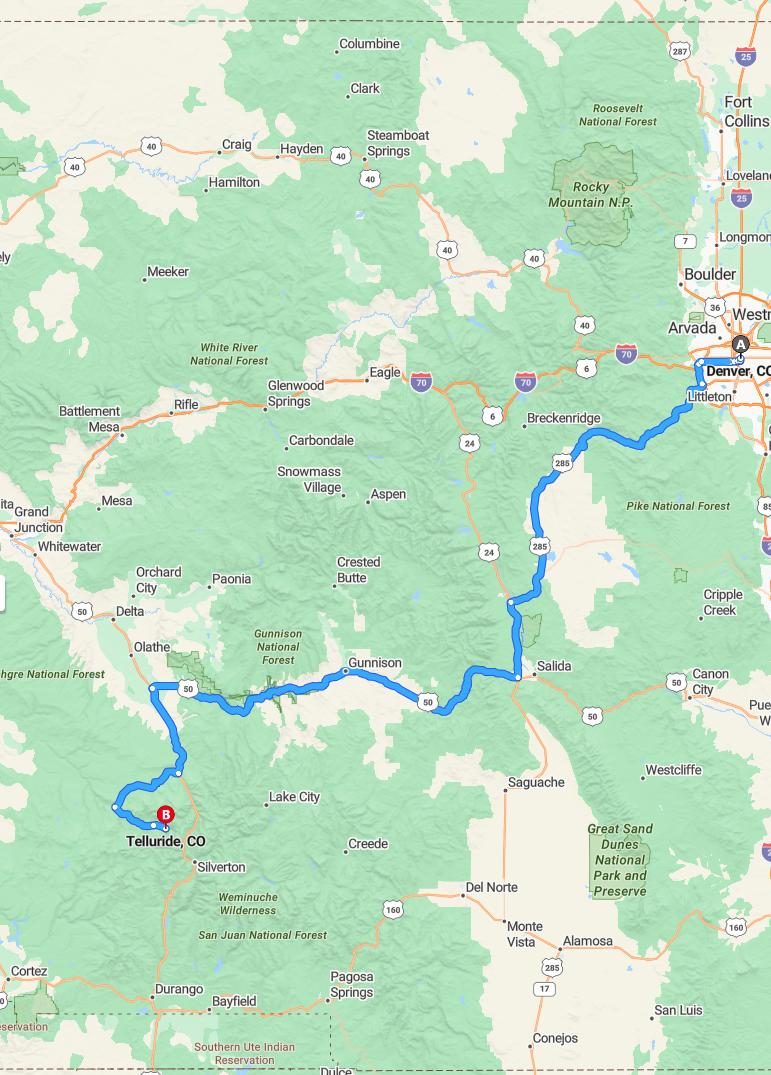Distance and estimated driving time
The drive from Denver to Telluride covers approximately 330 miles along US-285 S and US-50 W. The journey is typically estimated to take around 5 hours and 59 minutes, depending on traffic and road conditions. Travelers should plan for a nearly six-hour trip, enjoying scenic views along this route through Colorado's diverse landscapes. Preparing for the drive with necessary supplies and check-in times ensures a smooth and enjoyable adventure.
Driving route
Embarking on a scenic drive from Denver to Telluride offers an incredible journey through Colorado's diverse landscapes. Starting in Denver, travelers pass through Littleton, a charming suburb with appealing local attractions. Continuing southwest, the route takes you to Salida and Gunnison, towns renowned for their vibrant arts communities and outdoor recreation opportunities. Further along, the trail leads to Silverton, a historic mining town nestled amidst stunning mountain scenery. Finally, the drive culminates in the picturesque mountain town of Telluride, celebrated for its breathtaking vistas and lively cultural scene.

Best Time to Travel from Denver to Telluride
The best time to travel from Denver to Telluride depends on your preferred outdoor activities and weather conditions. Summer, from June to August, offers warm temperatures and is ideal for hiking, mountain biking, and festivals, while late spring and early fall provide fewer crowds and stunning panoramic views with colorful foliage. Winter, from December to March, transforms the region into a snowy paradise perfect for skiing and snowboarding, especially in Gunnison and Silverton. Ultimately, for pleasant weather and outdoor adventures, late spring and early fall are considered the most favorable times to make the scenic drive through Littleton, Salida, Gunnison, Silverton, and into Telluride.
Scenic Spots along the Denver to Telluride Route
The drive from Denver to Telluride offers a breathtaking journey through some of Colorado's most scenic spots. Beginning in Denver, travelers can enjoy panoramic city views before heading south through Littleton's charming neighborhoods. As the route progresses, the landscape transforms near Salida and Gunnison, revealing lush meadows and mountainous vistas. Continuing into Silverton and finally Telluride, visitors are treated to stunning mountain ranges, pristine forests, and historic mining towns nestled within the rugged Rockies, making this a truly memorable scenic adventure.
Travel Tips for a Safe Journey
For a safe journey from Denver to Telluride, plan your route ahead and check weather conditions, especially in mountainous areas like Gunnison and Silverton. Ensure your vehicle is well-maintained, with sufficient fuel, tires, and brake checks, since some roads may be steep or winding. Keep an emergency kit, snacks, and water in your car, and make regular stops in towns like Littleton and Salida to rest and stretch. Lastly, drive attentively, adhere to speed limits, and be cautious of changing weather or road conditions to enjoy a smooth and safe trip through Colorado's scenic landscapes.
Recommended Stops for Food and Rest
As you journey from Denver to Telluride, there are several recommended stops for food and rest to enhance your trip. In Littleton, enjoy a variety of local cafes and casual dining options perfect for a quick bite or a relaxing break. Salida offers charming eateries and scenic spots to stretch your legs while savoring regional flavors. Gunnison and Silverton both boast cozy restaurants and welcoming rest areas, providing ideal locations to recharge before reaching the stunning mountain town of Telluride.
Weather Conditions to Consider Before Departure
Before departing from Denver to Telluride, travelers should carefully review current weather conditions along the route. Winter months may bring snow and icy roads in mountain areas like Gunnison and Silverton, requiring winter tires or chains for safe travel. Spring and fall can also experience sudden storms or rain, impacting visibility and driving safety. It is essential to check for any closures or alerts along the route to ensure a smooth and safe journey through the scenic Colorado mountains.
Vehicle Preparation for Mountain Driving
Before embarking on a mountain drive from Denver to Telluride, ensure your vehicle is properly prepared for challenging terrain and variable weather conditions. Check tire tread and pressure to maintain optimal traction on steep and winding roads, and top off all fluid levels, including antifreeze, to prevent overheating or freezing. Inspect your brakes and ensure the engine and transmission are in good condition, as mountain driving requires reliable performance for ascents and descents. Additionally, equip your vehicle with emergency supplies such as a first aid kit, extra blankets, and a charged phone, to stay safe during unforeseen circumstances in remote areas like Silverton and Gunnison.
Alternative Routes from Denver to Telluride
There are several alternative routes to travel from Denver to Telluride, offering scenic and efficient options. One popular alternative involves driving west on Interstate 70 to reach Silverthorne, then heading south on U.S. Highway 50 through Montrose before arriving in Telluride. Another option is to take U.S. Highway 285 south from Denver through Conifer and Poncha Springs, bypassing some mountain passes. Additionally, travelers can explore routes through Gunnison and Salida, which provide picturesque landscapes but may involve longer travel times, making them ideal for sightseeing enthusiasts.
Travel Budget Estimation for the Trip
Planning a road trip from Denver to Telluride involves estimating a budget that accounts for fuel, food, accommodations, and activities. The approximately 370-mile route passes through Littleton, Salida, Gunnison, Silverton, and finally Telluride, with fuel costs varying based on vehicle efficiency. Budgeting for overnight stays in scenic towns like Gunnison and Silverton can differ, so accommodations should be booked in advance for better rates. Additionally, allocating funds for meals and optional tours or activities along the way will ensure an enjoyable and stress-free journey within your budget.
